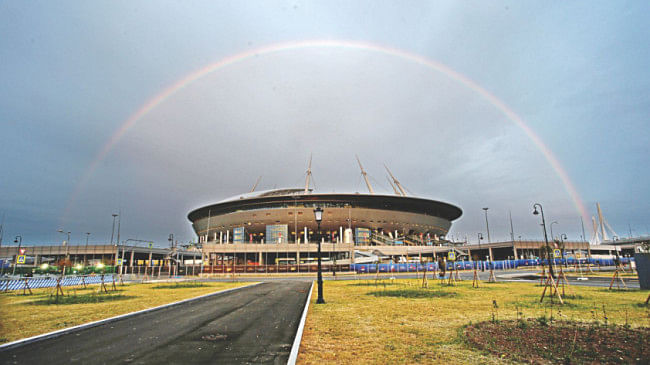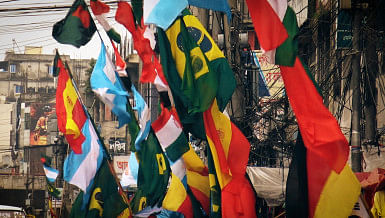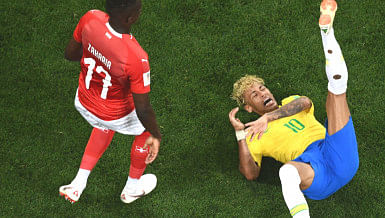As soon as we exited the Novokrestovsky Metro Station, the first thing that struck us most was a beautiful stadium, which has already earned the nickname 'the flying saucer' and seems to have just landed in the Gulf of Finland from another planet. The venue will host seven World Cup games, including a semifinal, and in the next few days will feature crucial group phase matches of Argentina and Brazil.
This is the Saint Petersburg Stadium, which will become the new home of Russia's biggest club, FC Zenit Saint Petersburg, after the World Cup. The whole 76,000-capacity stadium and its surroundings are a beholders delight. If you walk towards the venue from the metro station, which is actually purpose-built for fans, you will find a bridge that connects Krestovsky Island to the south bank of the Primorsky District. If you walk through the vast open space between the entrance to the stadium and the metro station, you will see the waves of the Baltic Sea hitting high concrete walls.
Not far from view you will find a few anchored tourist cruise ships before they travel to Finland. The other side of the stadium has an amusement park, where fans without match-tickets can enjoy the festivity regardless. Since the area is close to the sea, the temperature here is always remains very pleasant. When we arrived, it was a gloomy day and rained afterwards but the venue, with a retractable roof and pitch, is always ready to adjust to any unfriendly weather. Looking at the venue and working in the makeshift press centre gave us an impression that the whole concept of the stadium was to better serve the fans. The same can be said for the purpose of the entire Russian establishment, be it Moscow or in Saint Petersburg, all the efforts seem to be directed towards serving the citizens better.
Before heading to the stadium, we took a trip to Saint Petersburg Football Museum, a 20-minute walk from the train station. However, as far as Google maps is concerned, it should have been a seven-minute walk but that is perhaps because it is designed for fleet-footed Russians.
After visiting the venue, where we surprisingly found Russian translator Fariza Bitaceva, we took a detour through a park. It was not only big but also had everything from children's playgrounds to fishing at two spectacular lakes and boating and painting in perfect settings. It was a park with numerous amusements and facilities for the locals, something we can only dream of in Bangladesh.
Smooth sailing on the Moscow metro
You will never feel lost in the big city of Moscow, that is if you carry the precious guide to their cobweb-esque metro line. There are as many as 17 different metro and monorail lines, including two which run in a circle in the Russian capital.
From any single one of these metro stations one can easily reach any given destination, which has been a huge help to the travelling fans from across the world and much to their delight, the mayor of Moscow decided to keep the commuters lifeline open round the clock through the course of the World Cup.
Although the Moscow Metro is enormous in size, it operates ceaselessly so do not get upset if you miss a train, another one will arrive the very next minute.
Although language is the biggest barrier in communicating with the locals, city officials have made every effort to guide the fans to the two venues -- the Luzhniki and Spartak Moscow stadiums – with easily noticeable signs in English spread about.
Aside from that they also placed volunteers, donning spectacular jackets, at certain points to help and guide fans. It is only due to the massive and well coordinated metro system that the organisers could flush out the 78,000 fans, who attended the Germany-Mexico game, in an hour from the Luzhniki Stadium.
The Sher-e-Bangla National in Mirpur has a mere capacity of 34 thousand and yet fans have to endure a four to six hour hassle to enter or exit the ground during match days. The city of Dhaka itself reaches a standstill during any key cricket match in Mirpur, guaranteeing a full house at the home of the country's cricket.
After the opening match at Luzhniki, the convoy carrying Russian president Vladimir Putin hit the road and caused only slight traffic in the process, a stark contrast to when VIP as such makes a move in Bangladesh.
We can all agree that subways could greatly decrease the suffocating traffic in Dhaka but it remains a distant reality in a country where the overhaul of the railway system has never been acknowledged as a top priority. Subways are like the lifelines of any large city in the world and if we want Dhaka to survive its own growth, then it is about time that the Bangladesh Railway gets all the attention rather than those highways and bridges.




 For all latest news, follow The Daily Star's Google News channel.
For all latest news, follow The Daily Star's Google News channel. 









Leave your comments